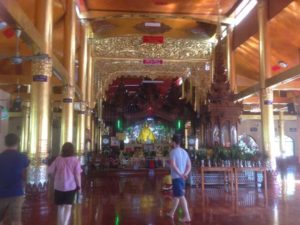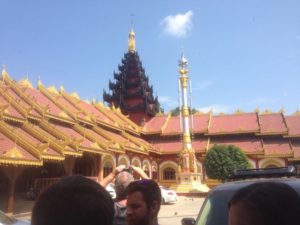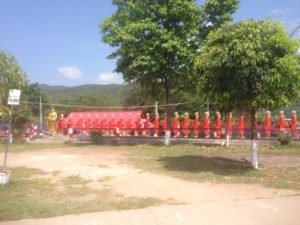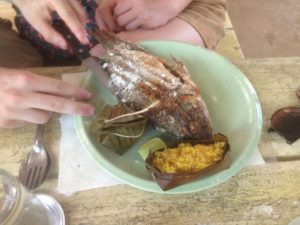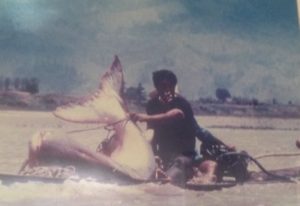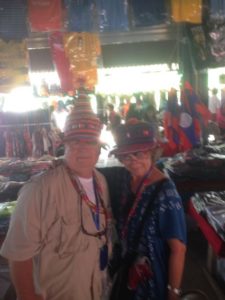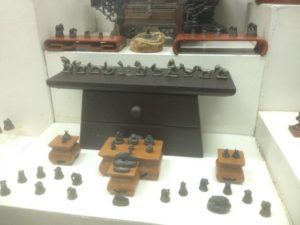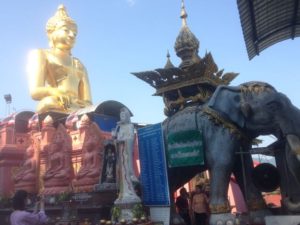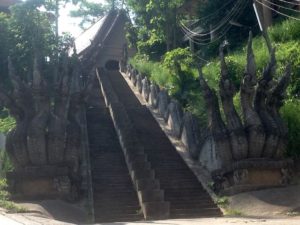Mae Sai is a market town in the northermost point of Thailand.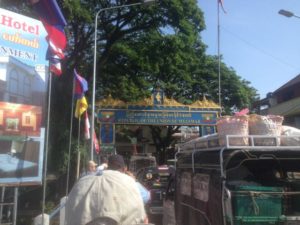
We were able to walk across the Thai border into Myanmar with the help of our Gate 1 guide, Ron, who arranged for a day pass for our group, which meant we did not have to stand in lines or have our passport stamped. We were met by a local guide who led us to motorized tricycles that took us through back streets where we would never have been able to go without a guide.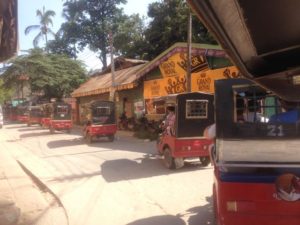
The first temple we visited, LaKang, was built of teak. The temple had extensive grounds and is constantly being added to.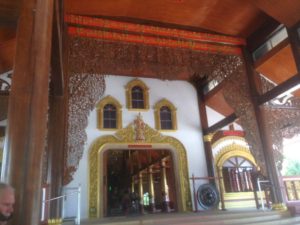
The interior has golden pillars. The entrance is typical of Burmese architecture.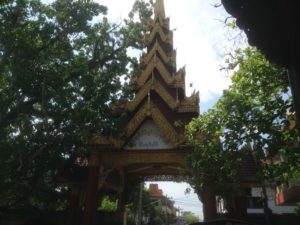
Ron then led us through the market, which was crowded with motor scooters, and full of intense smells, sights, and sounds. We had a chance to taste beetle nut and beetle leaf as well as moonshine. (He said we were breaking all the Buddhist principles in one day.)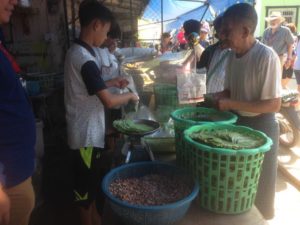
The market has no refrigeration, so everything must be bought fresh in the morning. Lots of evidence of flies on fresh meat.
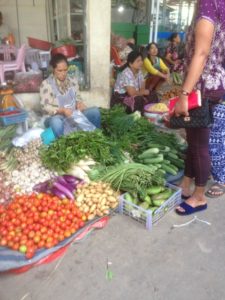
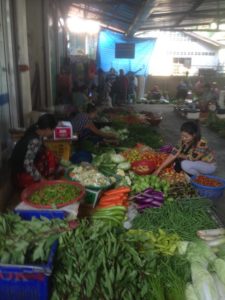 After the market, we got back on the tricycles and climbed the hill to the Shwedagon Pagoda with it procession of monk statues at the entrance and its enormous golden stupa.
After the market, we got back on the tricycles and climbed the hill to the Shwedagon Pagoda with it procession of monk statues at the entrance and its enormous golden stupa.
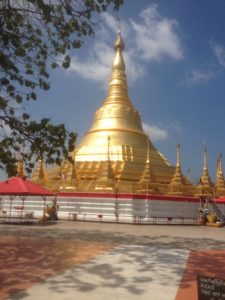 Many Burmese wore what looked like yellow paint on their face, which is a treatment that is supposed to be good for the skin. We got a demonstration of how it is made from young girls at the temple. Kanaka wood is found in to a paste that is then spread on the face.
Many Burmese wore what looked like yellow paint on their face, which is a treatment that is supposed to be good for the skin. We got a demonstration of how it is made from young girls at the temple. Kanaka wood is found in to a paste that is then spread on the face.
We had to wear sarongs to enter the temple. 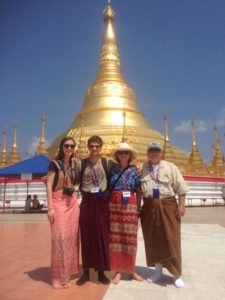 A pack of girls followed us into the temple and held umbrellas over our heads to protect us from the intense sun.
A pack of girls followed us into the temple and held umbrellas over our heads to protect us from the intense sun.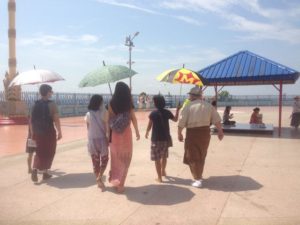
As a way of paying them we bought hand painted post cards from them.
We then boarded our bikes and wended our way through very primitive back streets to the Peace Golden Land Buddhist Nunnery. 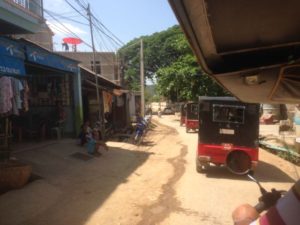
Girls and boys can be sent to a temple or nunnery at the age of seven where they live as novitiates, and the monks or nuns educate them. After their education, they can choose whether to stay or leave the nunnery. 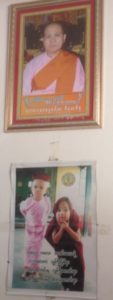 The novitiates performed a blessing chant for us.
The novitiates performed a blessing chant for us.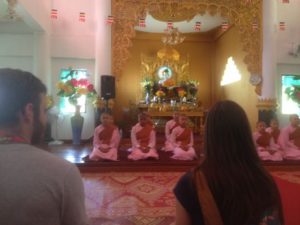
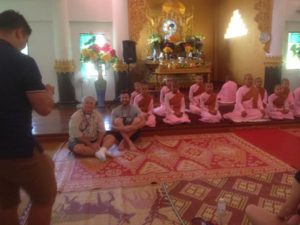 Some of the foods we had a chance to taste were lychee fruit, tamarind, and roasted fava beans.We then left the Golden Triangle, where Thailand, Myanmar, and Laos meet and crossed back over the border to Thailand.
Some of the foods we had a chance to taste were lychee fruit, tamarind, and roasted fava beans.We then left the Golden Triangle, where Thailand, Myanmar, and Laos meet and crossed back over the border to Thailand. 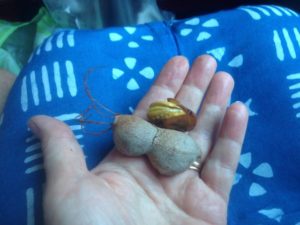
 Ron had told us we would be met by limousines that would take us to a lunch prepared by a friend of his. The limousines turned out to be ancient trucks powered by hand cranked engines, which I think all of us enjoyed much more than we would have limousines.
Ron had told us we would be met by limousines that would take us to a lunch prepared by a friend of his. The limousines turned out to be ancient trucks powered by hand cranked engines, which I think all of us enjoyed much more than we would have limousines. 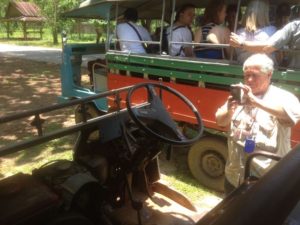 The trucks took us up in the hills where no bus could have gone. We saw rubber tree plantations, sugar cane, and lots of pineapples.
The trucks took us up in the hills where no bus could have gone. We saw rubber tree plantations, sugar cane, and lots of pineapples.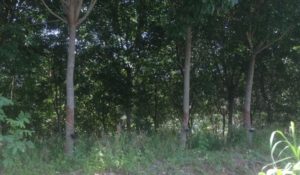
Along the way we saw how some of the hill tribe refugees live in open air dwellings.When it turns cold, they have problems because they have no heat and no warm clothing. The woman who prepared lunch for us helps the Akha children around her by teaching them drawing and allowing the to sell wares to visitors. The children were adorable.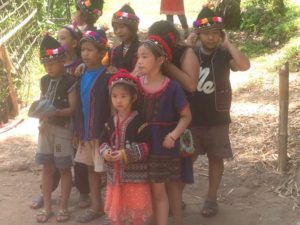
Lunch was either whole grilled tilapia or chicken. Everyone agreed it was delicious.
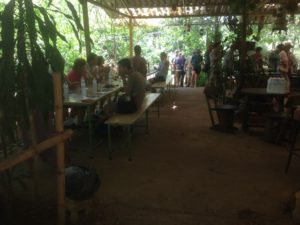 After lunch, our limos drove us to the Mekong River, where we boarded long boats to cross the Mekong River and stopped on the Island of Don Sao in Laos, an island developed by the Chinese, who have purchased a 99 year lease of 70 kilometers of the Laotian land on the Mekong River and plan to move 1 million Chinese in to live there. The pace of development is astronomical. Huge casinos are being built and all the structures on the island where we landed have been built since November.
After lunch, our limos drove us to the Mekong River, where we boarded long boats to cross the Mekong River and stopped on the Island of Don Sao in Laos, an island developed by the Chinese, who have purchased a 99 year lease of 70 kilometers of the Laotian land on the Mekong River and plan to move 1 million Chinese in to live there. The pace of development is astronomical. Huge casinos are being built and all the structures on the island where we landed have been built since November.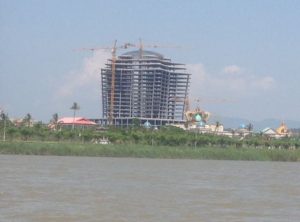
The Laotians may soon regret their decision.
On the Thai side of the Mekong, poor fishermen live on the river bank and fish for giant catfish when river traffic calms down. 
The Mekong flows almost 5,000 kilometers, beginning in the snow melt of the Himalayas and entering China, Thailand, Myanmar, Laos, Cambodia, and Vietnam. Unfortunately, the Chinese have damed the river and release water without warning, often flooding communities downriver. They also want to deepen the river to accommodate larger boats, something the other countries object to.
The island was more a Chinese market place than Laos. We were greeted by the offer of welcome drinks of alcohol with cobras, scorpions, and endangered species parts in it.
We did manage to buy two hill tribe hats that will be a big hit back home.
Back across the river, we visited the House of Opium, which tells the fascinating story of opium, which originated in the Middle East and was brought to China and India by Alexander the Great. The British made huge profits by monopolizing the opium trade, which resulted in the Opium Wars, which China lost. During the early part of the twentieth century, the hill tribes brought opium with them to Thailand when they moved down to escape persecution. The museum has a huge collection of opium trade artifacts.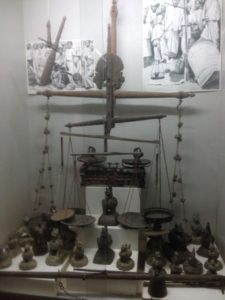
We also learned that the word bong comes from the Thai for bamboo pipe.
The Thai side also has a spectacular temple with an immense golden Buddha perched on what looks like a boat, so that he appears to float even at high tide.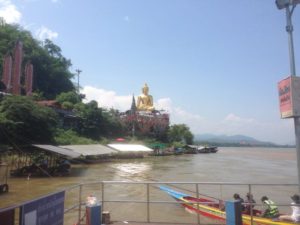
Beneath the golden Buddha is an altar for offerings.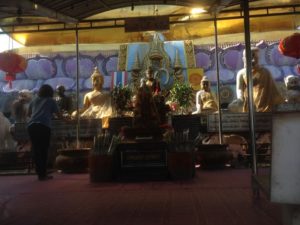
Beside the temple is a monument erected to honor the late king on his 72 birthday.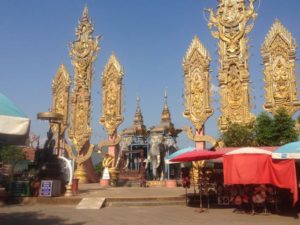
Across the street is the Wat Prathat Pukhao with its impressive naka (serpent) staircase.
Today was a remarkably full day in which we visited three countries and got a feeling of how other, less fortunate people, live.




